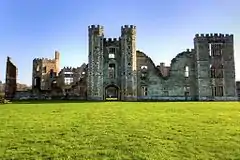Anthony-Maria Browne, 2nd Viscount Montagu
Anthony-Maria Browne (1574 – 23 October 1629) was an English peer during the Tudor and Stuart period.
Anthony-Maria Browne | |
|---|---|
 The ruins of Cowdray House | |
| Born | 1574 |
| Died | 23 October 1629 |
| Buried | Midhurst, Sussex |
| Noble family | Browne |
| Spouse(s) | Jane Sackville |
| Issue
Francis Browne Anthony Browne Francis Browne, 3rd Viscount Montagu Mary Browne Katherine Browne Mary Browne (again) Frances Browne Anne Browne Lucy Browne | |
| Father | Anthony Browne |
| Mother | Mary Dormer |
He was born in 1574, the son of Anthony Browne (22 July 1552 – 29 June 1592),[1] eldest son of Anthony Browne, 1st Viscount Montagu, and Mary Dormer. He became the Second Viscount Montagu at the age of 18 on the death of his grandfather in 1592,[2] from whom he inherited an estate worth between £3600 and £5400 per annum.[3]
In 1591 Browne married Jane Sackville, daughter of Thomas Sackville, 1st Earl of Dorset, and by her had issue:[4]
- Francis Browne (died young).
- Anthony Browne (died young).
- Francis Browne, 3rd Viscount Montague, who married Elizabeth Somerset, the daughter of Henry Somerset, 1st Marquess of Worcester.
- Mary Browne, who married firstly, William Paulet (d.1621), Lord St. John, eldest son of William Paulet, 4th Marquess of Winchester, and secondly, William Arundell, esquire, of Horningsham, Wiltshire, second son of Thomas Arundell, 1st Baron Arundell of Wardour, and Mary Wriothesley, the daughter of Henry Wriothesley, 2nd Earl of Southampton, by Mary Browne, daughter of Anthony Browne, 1st Viscount Montague.
- Catherine Browne, who married William Tyrwhit.
- Mary Browne (d. January 1685), who married Robert Petre, 3rd Baron Petre (d. October 1638).
- Frances Browne, who married John Blomer.
- Anne Browne, who became a nun.
- Lucy Browne, who became a nun.
Anthony-Maria Browne was arrested in connection with the Gunpowder Plot and spent about a year in the Tower of London.
In 1595, he wrote a book on how to manage a nobleman's household entitled "A Booke of Orders and Rules".[5]
He died on 23 October 1629 and is buried in Midhurst Church.
Footnotes
- Richardson, Douglas, Magna Carta Ancestry, 2nd ed., vol. III, pp. 228–9.
- Cokayne, G. E. Complete Peerage Reprinted Gloucester 2000 Vol. IX, p. 100
- Elzinga 2004; Scott 1854, p. 173.
- Questier 2006, p. 522; Richardson I 2011, p. 45; Scott 1854, p. 173.
- Scott 1854, p. 173.
References
- Elzinga, J.G. (2004). Browne, Anthony, first Viscount Montagu (1528–1592). Oxford Dictionary of National Biography. Retrieved 8 December 2012.CS1 maint: ref=harv (link) (subscription required)
- Questier, Michael C. (2006). Catholicism and Community in Early Modern England. Cambridge: Cambridge University Press.CS1 maint: ref=harv (link)
- Richardson, Douglas (2011). Magna Carta Ancestry: A Study in Colonial and Medieval Families, ed. Kimball G. Everingham. I (2nd ed.). Salt Lake City. ISBN 1449966373
- Scott, Sibbald David, ed. (1854). "A Booke of Orders and Rules of Anthony Viscount Montague in 1595". Sussex Archaeological Collections. London: John Russell Smith. VII: 173–212. Retrieved 8 December 2012.CS1 maint: ref=harv (link)
- Trull, Mary E. (2013). Performing Privacy and Gender in Early Modern Literature. London: Palgrave Macmillan.CS1 maint: ref=harv (link)
External links
- Anthony Viscount Montague's "A Book of Orders and Rules", by Sir Sibbald David Scott, in Sussex Archaeological Collections, vol. vii, London (1854) at Google Books
- Portrait of Anthony Maria Browne and his brothers John and William, by Isaac Oliver (1598), in the Burghley House Collection in Stamford, UK
| Peerage of England | ||
|---|---|---|
| Preceded by Anthony Browne |
Viscount Montagu 1592–1629 |
Succeeded by Francis Browne |